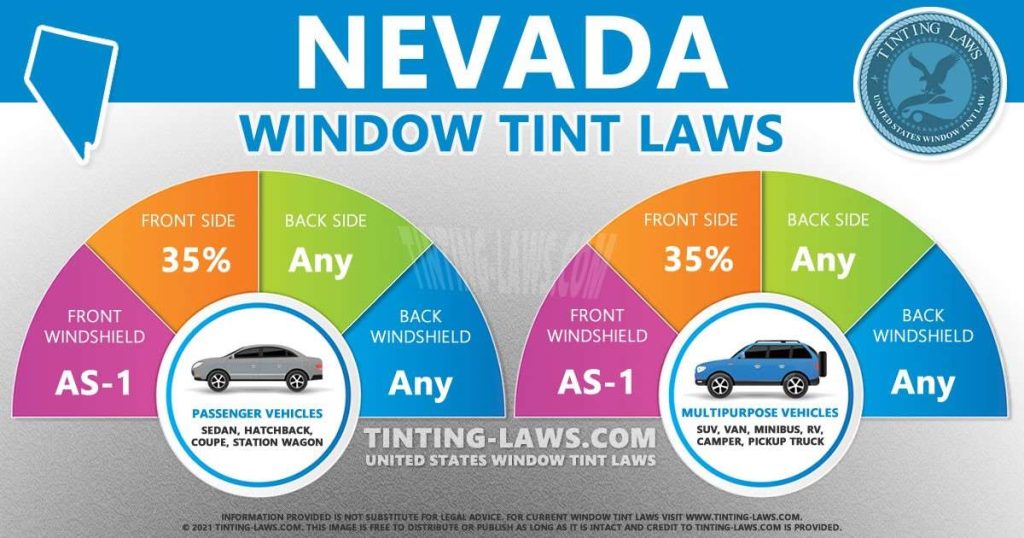Nevada Window Tinting Laws
Car window tinting laws in Nevada were enacted in 1993.
We have provided all the necessary information about your car’s window tint, including how dark or reflective the tint is allowed in your state.
There are also additional car window tinting rules and regulations in Nevada so make sure you read all about it below.
Window tint darkness in Nevada
The percent of visible light allowed through your car windows is called VLT: Visible Light Transmission.
The percentage of light allowed through your film and glass in Nevada is very specific and different for sedan cars and SUV cars or vans.
Tint darkness for sedans:
- Windshield: Non-reflective tint is allowed above the manufacturer’s AS-1 line.
- Front Side windows: Must allow more than 35% of light in.
- Back Side windows: Any darkness can be used.
- Rear Window: Any darkness can be used.
Tint darkness for SUV and vans:
- Windshield: Non-reflective tint is allowed above the manufacturer’s AS-1 line.
- Front Side windows: Must allow more than 35% of light in.
- Back Side windows: Any darkness can be used.
- Rear Window: Any darkness can be used.
Window tint reflection in Nevada
Window tint can reflect incoming light and reduce glare and heat.
Nevada window tint law permits a certain window reflection when using a tint so make sure you pay attention to this as well.
Tint reflection for sedans:
- Front Side windows: No reference to reflectivity in the current law.
- Back Side windows: No reference to reflectivity in the current law.
Tint reflection for SUV and vans:
- Front Side windows: No reference to reflectivity in the current law.
- Back Side windows: No reference to reflectivity in the current law.
Other Nevada window tint rules and regulations:
Nevada does have several other important laws, rules and regulations pertaining to window tinting. They include the following:
- Side Mirrors: Dual side mirrors are required if back window is tinted.
- Restricted Colors: Colors RED and AMBER are not permitted.
- Tint Variance: State laws allow 7% light transmission tolerance.
- Certificates: Manufacturers of film need to certify the film they sell in Nevada. Ask your dealer if they are using certified film.
- Stickers: No sticker to identify legal tinting is required.
- Medical Exceptions: Nevada allows medical exemptions for special tint.
Keep in mind that Nevada tinting laws and regulations may be interpreted differently in your county or place of residence.
We always recommend double-checking our information with your local DMV or law enforcement authorities.

Our information about window tint laws in Nevada was last updated in 2024.
Tinting laws in Nevada were enacted in 1993.
In case any of our info provided is not up to date or correct be sure to contact us so we can fix it. Thanks!
Trusted industry leader in providing accurate window tint laws. Share with confidence:
State of Nevada Info
Nevada is a state in the western, mountain west, and southwestern regions of the United States.
Nevada is the 7th most extensive, the 35th most populous, and the 9th least densely populated of the 50 United States.

Over two-thirds of Nevada’s people live in Clark County, which contains the Las Vegas–Paradise metropolitan area where the state’s three largest incorporated cities are located.
The establishment of legalized gambling and lenient marriage and divorce proceedings in the 20th century transformed Nevada into a major tourist destination.
Nevada is the only state in the U.S. where prostitution is legal.
The tourism industry remains Nevada’s largest employer, with mining continuing to be a substantial sector of the economy as Nevada is the fourth largest producer of gold in the world.
Capital: Carson City
Population: 2,758,931
Area: 110,622 sq mi (286,367 km2)
Cities in Nevada: Las Vegas, Reno, Carson City, Henderson, North Las Vegas, Elko, Boulder City, Sparks, Virginia City, Mesquite, Winnemucca, Jackpot, Ely, Summerlin, Primm, West Wendover, Fallon, Goldfield, Caliente, Rhyolite, Fernley, Alamo, Panaca, Lovelock, Silver Zone, Eureka, Genoa, Yerington, Currant, Mercury, Pioche, Carvers, Lida, Overton, Austin, Nelson, Wells, Coyote Springs, Logandale, Amargosa Valley, Jean, Carlin, Silver Peak, Cobre, Contact, Bonnie Springs, Delamar, Carson Hot Springs, Sun City Summerlin
Counties in Nevada: Carson City, Churchill, Clark, Douglas, Elko, Esmeralda, Eureka, Humboldt, Lander, Lincoln, Lyon, Mineral, Nye, Pershing, Storey, Washoe, White Pine
Tint law references:
Nevada Revised Statutes section 484.6195: Restrictions on tinting
Medical exemption info:
Nevada Department of Public Safety – Application for Window Tint Exemption (.pdf file)